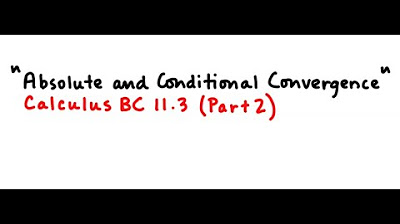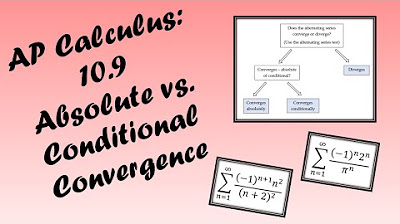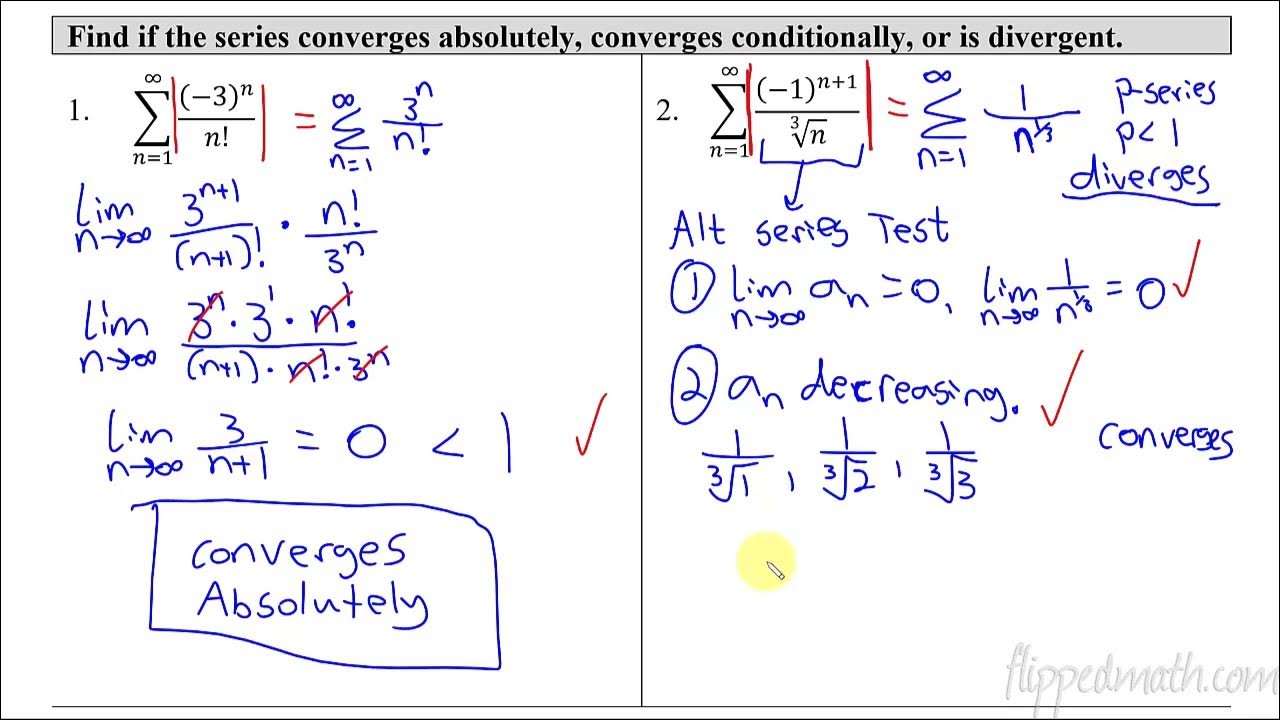Conditional & absolute convergence | Series | AP Calculus BC | Khan Academy
TLDRThis video script discusses the concept of conditional and absolute convergence in the context of infinite series. It starts with an example of an alternating series that converges, then explores what happens when taking the absolute value of its terms, leading to the divergence of the harmonic series. The script explains the difference between conditional convergence, where a series converges but the absolute values diverge, and absolute convergence, where the series still converges after taking absolute values, using a geometric series as an example. The video aims to clarify these nuanced aspects of series convergence.
Takeaways
- 📚 The script introduces the concept of the Alternating Series Test, a method used to determine if an infinite alternating series converges.
- 🌟 The example series provided is \( \sum_{n=1}^{\infty} (-1)^{n+1} \frac{1}{n} \), which converges according to the Alternating Series Test.
- 🔍 When taking the absolute value of each term in the series, the result is the Harmonic Series \( \sum_{n=1}^{\infty} \frac{1}{n} \), which is known to diverge.
- 📉 The divergence of the Harmonic Series highlights the conditional nature of convergence for the original alternating series.
- 🔑 A series that converges but diverges when taking the absolute value of its terms is said to converge conditionally.
- 🔄 The concept of 'absolute convergence' is introduced for series that still converge even after taking the absolute value of each term.
- 🌐 The script suggests reviewing the Alternating Series Test and the proof of divergence for the Harmonic Series on Khan Academy.
- 📈 An example of absolute convergence is given with a geometric series \( \sum_{n=1}^{\infty} (-\frac{1}{2})^{n+1} \), which also converges when considering the absolute value of its terms.
- 📝 The importance of understanding the nuances of convergence is emphasized, distinguishing between conditional and absolute convergence.
- 📚 The script serves as an educational resource to deepen the understanding of series convergence beyond the basic concepts of convergence or divergence.
- 🎓 It encourages viewers to explore further by watching relevant videos on Khan Academy for a deeper understanding of the topics discussed.
Q & A
What is the alternating series test?
-The alternating series test is a method used in calculus to determine whether an infinite series with alternating signs converges. It is applicable when the terms of the series decrease in absolute value and approach zero.
What is the series used as an example in the video to apply the alternating series test?
-The series used as an example is \( \sum_{n=1}^{\infty} (-1)^{n+1} \frac{1}{n} \), which starts with 1, -1/2, 1/3, -1/4, and so on.
What happens when you take the absolute value of each term in the alternating series?
-Taking the absolute value of each term in the series results in the sum \( \sum_{n=1}^{\infty} \frac{1}{n} \), which is the harmonic series.
Is the harmonic series convergent or divergent?
-The harmonic series is divergent, as shown in the video and proven in various mathematical sources.
What does it mean for a series to converge conditionally?
-A series converges conditionally if it converges when the terms are not necessarily non-negative, but the series formed by taking the absolute value of each term diverges.
What is the difference between conditional convergence and absolute convergence?
-A series converges absolutely if it converges and remains convergent even when the absolute values of the terms are taken. Conditional convergence occurs when the series converges but diverges when the absolute values of the terms are taken.
What is an example of a series that converges absolutely?
-An example given in the video is the geometric series \( \sum_{n=1}^{\infty} (-1/2)^{n+1} \), which converges and also converges when the absolute values of the terms are taken.
Why is the geometric series \( \sum_{n=1}^{\infty} (-1/2)^{n+1} \) considered to converge?
-This geometric series converges because the absolute value of the common ratio (1/2) is less than one, which is a condition for convergence in geometric series.
What is the sum of the series \( \sum_{n=1}^{\infty} (-1/2)^{n+1} \) when the absolute value of each term is taken?
-When the absolute value of each term is taken, the series becomes \( \sum_{n=1}^{\infty} \frac{1}{2^{n+1}} \), which is still a convergent geometric series.
What is the significance of the absolute value in determining the type of convergence of a series?
-The absolute value of the terms in a series can determine whether the series converges absolutely or conditionally. If the series converges regardless of the signs of the terms, it is said to converge absolutely. If it only converges when the signs are ignored (i.e., when the absolute values are taken), it converges conditionally.
Outlines
🔍 Introduction to Alternating Series Test
This section introduces the concept of the alternating series test using an infinite series example: the series from n equals one to infinity of (-1)^(n+1)/n. The voiceover mentions that this series, represented by 1 - 1/2 + 1/3 - 1/4 and so on, converges according to the alternating series test. It briefly reviews the proof of convergence and sets up the exploration of absolute values of the series terms.
📈 Absolute Value and Harmonic Series
The narrator discusses the result of taking the absolute value of each term in the alternating series. The absolute value changes the series to the famous harmonic series, 1 + 1/2 + 1/3 + ..., which diverges. This section highlights the concept of conditional convergence, where a series converges but its absolute value counterpart diverges.
🌀 Conditional vs Absolute Convergence
The explanation differentiates between conditional and absolute convergence. If a series converges but its absolute value diverges, it is conditionally convergent. Conversely, if the series and its absolute value both converge, it is absolutely convergent. An example of a geometric series is used to illustrate absolute convergence, showing that when the absolute value of terms still leads to a convergent series, it is absolutely convergent.
🔄 Geometric Series Example
The narrator provides an example of a geometric series, demonstrating that the series and its absolute value both converge. The geometric series considered is the sum from n equals one to infinity of (-1/2)^(n+1). The absolute value of this series, 1/2^(n+1), also converges, confirming that the series converges absolutely. This example reinforces the distinction between conditional and absolute convergence.
🧩 Nuances of Convergence
This part concludes the discussion by summarizing the nuances of convergence. It reiterates that understanding whether a series converges conditionally or absolutely provides deeper insight into its behavior. The importance of considering the absolute value of series terms in determining the type of convergence is emphasized, rounding off the video’s exploration of these convergence concepts.
Mindmap
Keywords
💡Alternating Series Test
💡Convergence
💡Harmonic Series
💡Conditionally Convergent
💡Absolutely Convergent
💡Geometric Series
💡Common Ratio
💡Absolute Value
💡Divergence
💡Infinite Series
💡Reciprocal
Highlights
Introduction of the alternating series test with an example series.
Proof of convergence for the example series using the alternating series test.
Exploration of the effect of taking the absolute value of terms in a series.
Transformation of an alternating series into a harmonic series by taking absolute values.
Explanation of the harmonic series and its divergence.
Conditional convergence concept introduced through the harmonic series example.
Definition of 'conditionally convergent' series.
Definition of 'absolutely convergent' series.
Geometric series example demonstrating absolute convergence.
Verification of the geometric series' convergence after taking absolute values.
Discussion on the importance of the common ratio in determining series convergence.
Clarification of the difference between conditional and absolute convergence.
Introduction of nuances in series convergence through examples.
Highlighting the practical application of understanding conditional and absolute convergence in series.
Encouragement to review the video on the alternating series test for further understanding.
Suggestion to look up the proof of divergence for the harmonic series on Khan Academy.
Transcripts
Browse More Related Video
5.0 / 5 (0 votes)
Thanks for rating:





